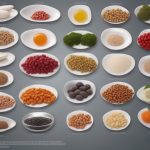Maintaining adequate hydration is fundamental to overall health, but many people experience frustrating fluctuations in urine output after meals – feeling like they’re constantly running to the bathroom. This isn’t necessarily a sign of illness, but rather often a consequence of dietary choices that rapidly shift fluid balance within the body. Understanding how different food components affect your kidneys and bladder is key to crafting lunches that are both nourishing and manageable for those seeking more stable hydration. It’s about finding the sweet spot between fueling your body and avoiding excessive trips to the restroom, allowing you to stay productive and comfortable throughout your afternoon.
The feeling of needing to urinate frequently post-lunch often stems from osmotic pressure – how water moves across cell membranes based on concentration gradients. Certain foods draw more water into the digestive system, increasing blood volume which then signals the kidneys to process more fluid. Other components like caffeine or high sodium levels amplify this effect. This article will explore strategies for building balanced lunches that minimize these fluctuations, focusing on food choices and combinations that support consistent hydration without triggering a surge in urine production. We’ll move beyond simple avoidance of diuretics and delve into practical ways to enjoy satisfying meals while maintaining better control over your body’s natural processes.
The Role of Macronutrients in Urine Output
Macronutrients – carbohydrates, proteins, and fats – all influence how our bodies handle fluids, but to varying degrees. Carbohydrates, particularly refined sugars and simple starches, can cause a rapid influx of glucose into the bloodstream. This triggers an osmotic effect, drawing water from surrounding tissues into the blood, leading to increased urine production as the kidneys work to filter out excess glucose. Complex carbohydrates found in whole grains, fruits, and vegetables are digested more slowly and have less dramatic impact on fluid balance. Choosing these options over processed carbs is a cornerstone of stable hydration.
Proteins also play a role, though typically less pronounced than carbohydrates. The metabolism of protein generates nitrogenous waste products that the kidneys must eliminate, requiring water. However, adequate protein intake is crucial for overall health and satiety – the goal isn’t to eliminate it, but rather to moderate portion sizes and pair it with sufficient hydration throughout the day. Fats, on the other hand, generally have a minimal impact on urine output. In fact, healthy fats can contribute to sustained energy levels and even aid in nutrient absorption, indirectly supporting better hydration by reducing cravings for sugary or salty snacks. If you’re looking for ways to support kidney health alongside dietary changes, consider exploring food choices that gently process urine.
Balancing these macronutrients is essential. A lunch that’s heavily skewed towards one – say, a large portion of pasta with minimal protein or vegetables – is more likely to cause fluid shifts than a well-rounded meal containing a moderate amount of each. Consider building your lunches around a foundation of complex carbohydrates (like quinoa or sweet potato), paired with lean protein (chicken, fish, beans) and healthy fats (avocado, olive oil).
Building the Ideal Lunch: Food Choices & Combinations
The key to minimizing post-lunch urination isn’t necessarily avoiding all “diuretic” foods, but rather understanding their impact and making informed choices. For example, cucumbers are often cited as diuretics, but they also provide hydrating electrolytes. The problem arises when large quantities of diuretic foods are consumed without adequate hydration or in combination with other fluid-shifting ingredients. Instead of focusing on restriction, aim for a balanced approach that incorporates hydrating foods while minimizing rapid osmotic shifts.
Consider these strategies: – Prioritize whole, unprocessed foods – they naturally contain more fiber and nutrients, leading to slower digestion and more stable blood sugar levels. – Pair carbohydrate sources with protein and fat – this slows down glucose absorption and reduces the spike in urine output. – Incorporate hydrating vegetables like celery or lettuce – these contribute to overall fluid intake without significantly increasing urination. – Limit refined sugars and processed foods – they are often high in sodium and can exacerbate fluid imbalances. For a more comprehensive understanding of dietary strategies, you might find urology diet plans helpful.
A practical example of a balanced lunch might be: grilled chicken salad with mixed greens, avocado slices, quinoa, and a light olive oil vinaigrette. This provides protein, healthy fats, complex carbohydrates, and hydrating vegetables – all working together to support stable hydration. It’s also important to note that individual tolerance varies significantly. What causes one person to experience increased urination may not affect another in the same way. Paying attention to your own body’s responses is crucial.
Hydration Strategies Beyond Food
While food choices are paramount, proper hydration throughout the day plays a critical role in managing urine output. Sipping water consistently rather than gulping large amounts at once helps maintain stable fluid balance. Consider spreading your water intake evenly between meals and snacks, aiming for small, frequent sips. Avoid consuming large volumes of liquid during lunch, as this can directly contribute to increased urination.
Furthermore, certain beverages are more likely to trigger diuresis than others. Caffeinated drinks (coffee, tea, soda) and alcohol are known diuretics, so moderating their intake is advisable if you’re sensitive to fluid fluctuations. Herbal teas like chamomile or peppermint can be good alternatives, offering hydration without the diuretic effect of caffeine. It’s also important to remember that hydration isn’t solely about water. Foods with high water content (like watermelon or berries) contribute significantly to your daily fluid intake. To further enhance your beverage choices, explore evening tea blends designed for minimal disruption.
Addressing Underlying Conditions and Seeking Guidance
If you experience consistently excessive urination despite making dietary adjustments, it’s important to rule out any underlying medical conditions. Several factors can contribute to frequent urination, including diabetes, urinary tract infections, overactive bladder, and certain medications. This information is not a substitute for professional medical advice. If you have concerns, consult with your doctor to determine the cause of your symptoms and receive appropriate treatment.
Finally, keeping a food diary can be an invaluable tool for identifying triggers. Track what you eat and drink, as well as your urine output throughout the day, to identify patterns and pinpoint specific foods or beverages that may be contributing to excessive urination. This personalized approach allows you to tailor your diet to your individual needs and sensitivities. Remember, achieving balanced hydration is about understanding your body’s unique responses and making informed choices that support your overall wellbeing.
The Impact of Sodium & Potassium
Sodium plays a significant role in fluid retention. High sodium intake causes the body to retain water, leading to increased blood volume and ultimately more urine production as the kidneys work to eliminate excess sodium. Processed foods are often laden with sodium, so prioritizing whole, unprocessed options is essential for minimizing its impact. Conversely, potassium helps counterbalance the effects of sodium by promoting fluid balance and kidney function. Increasing your intake of potassium-rich foods like bananas, sweet potatoes, spinach, and beans can help regulate fluid levels and reduce the likelihood of excessive urination.
A balanced approach to electrolytes isn’t about eliminating sodium entirely – it’s a necessary nutrient for bodily functions – but rather about maintaining a healthy ratio between sodium and potassium. Consider adding a pinch of sea salt to your meals (sea salt contains trace minerals) instead of using heavily processed table salt, and actively incorporating potassium-rich foods into your diet. It’s also important to be mindful of hidden sources of sodium in seemingly innocuous foods like bread or canned soups. For those concerned about overall kidney health, researching foods that help urine volume stay consistent can provide valuable insights.
Understanding the connection between diet and hydration is a proactive step toward better wellbeing. If you’re looking for additional strategies, consider exploring daily detox habits that are gentle on your system.
And remember, if you’re experiencing persistent issues, it’s always best to seek guidance from a healthcare professional. For further information about potential underlying causes, review why ignoring urine changes is not advisable.
Finally, maintaining healthy habits through consistent food choices and hydration can significantly impact your overall quality of life. If you’re looking for more guidance on dietary adjustments, foods that help the body flush excess urine could be a helpful starting point.





















